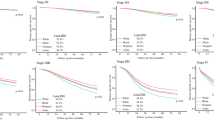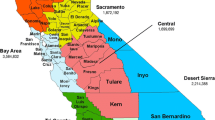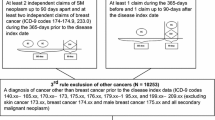Abstract
Introduction
Mortality from breast cancer among Black women is 60% greater than that of White women in South Carolina (SC). The aim of this study was to assess racial differences in mortality among Black and White breast cancer patients based on variations in social determinants and access to state-based early detection programs.
Methods
We obtained a retrospective record for breast cancer patients diagnosed between 2002 and 2010 from the SC Central Cancer Registry. Mortality was the main outcome while race-stratified Cox proportional hazard models were performed to assess disparities in mortality. We assessed effect modification, and we used an automated backward elimination process to obtain the best fitting models.
Results
There were 3286 patients of which the majority were White women (2186, 66.52%). Compared with married White women, the adjusted hazard ratio (aHR) for mortality was greatest among Black unmarried women (aHR 2.31, CI 1.83, 2.91). Compared with White women who lived in the Low Country region mortality was greatest among Black women who lived in the Midland (aHR 2.17 CI 1.47, 3.21) and Upstate (aHR 2.96 CI 1.96, 2.49). Mortality was higher among Black women that were not receiving services in the Best Chance Network (BCN) program (aHR 1.70, CI 1.40, 2.04) compared with White women.
Conclusions
To reduce the racial disparity gap in survival in SC, Black breast cancer patients who live in the Upstate, are unmarried, and those that are not enrolled in the BCN program may benefit from more intense navigation efforts directed at early detection and linkage to breast cancer treatments.

Similar content being viewed by others
References
Adams SA, et al. Breast cancer disparities in South Carolina: early detection, special programs, and descriptive epidemiology. J S C Med Assoc. 2006;102(7):231–9.
Adams SA, Smith ER, Hardin J, Prabhu-Das I, Fulton J, Hebert JR. Racial differences in follow-up of abnormal mammography findings among economically disadvantaged women. Cancer. 2009;115(24):5788–97.
Smith ER, Adams SA, Das IP, Bottai M, Fulton J, Hebert JR. Breast cancer survival among economically disadvantaged women: the influences of delayed diagnosis and treatment on mortality. Cancer Epidemiol Biomark Prev. 2008;17(10):2882–90.
Hebert JR, et al. Mapping cancer mortality-to-incidence ratios to illustrate racial and sex disparities in a high-risk population. Cancer. 2009;115(11):2539–52.
Brown D, Shao S, Jatoi I, Shriver CD, Zhu K. Trends in use of contralateral prophylactic mastectomy by racial/ethnic group and ER/PR status among patients with breast cancer: a SEER population-based study. Cancer Epidemiol. 2016;42:24–31.
Freedman RA, Virgo KS, He Y, Pavluck AL, Winer EP, Ward EM, et al. The association of race/ethnicity, insurance status, and socioeconomic factors with breast cancer care. Cancer. 2011;117(1):180–9.
Jatoi I, Anderson WF, Rao SR, Devesa SS. Breast cancer trends among black and white women in the United States. J Clin Oncol. 2005;23(31):7836–41.
Jatoi I, Becher H, Leake CR. Widening disparity in survival between white and African-American patients with breast carcinoma treated in the U.S. Department of Defense Healthcare system. Cancer. 2003;98(5):894–9.
Yedjou CG, et al. Health and racial disparity in breast cancer. Adv Exp Med Biol. 2019;1152:31–49.
American Cancer Society (2015) Cancer facts and figures 2015. Atlanta: American Cancer Society; 2015 [cited October 22nd 2017]. Available from https://www.cancer.org/research/cancer-facts-statistics/all-cancer-facts-figures/cancer-facts-figures-2015.html.
Shavers VL, Harlan LC, Stevens JL. Racial/ethnic variation in clinical presentation, treatment, and survival among breast cancer patients under age 35. Cancer. 2003;97(1):134–47.
Gajdos C, Tartter PI, Bleiweiss IJ, Bodian C, Brower ST. Stage 0 to stage III breast cancer in young women. J Am Coll Surg. 2000;190(5):523–9.
Newman LA. Breast cancer disparities: socioeconomic factors versus biology. Ann Surg Oncol. 2017;24:2869–75.
Chen L, Li CI. Racial disparities in breast cancer diagnosis and treatment by hormone receptor and HER2 status. Cancer Epidemiol Biomark Prev. 2015;24(11):1666–72.
Connors SK, Goodman MS, Myckatyn T, Margenthaler J, Gehlert S. Breast reconstruction after mastectomy at a comprehensive cancer center. Springerplus. 2016;5(1):955.
Reyes SA, King TA, Fei K, Franco R, Bickell NA. Factors affecting the completion of adjuvant chemotherapy in early-stage breast cancer. Ann Surg Oncol. 2016;23(5):1537–42.
Cancer Statistics. Surveillance, epidemiology, and end results. https://seer.cancer.gov/statistics/summaries.html. Accessed October 22nd 2017.
Jemal, A., et al., Annual report to the nation on the status of cancer, 1975-2014, featuring survival. J Natl Cancer Inst, 2017. 109(9).
Kohler BA, et al. Annual report to the nation on the status of cancer, 1975–2011, featuring incidence of breast cancer subtypes by race/ethnicity, poverty, and state. J Natl Cancer Inst. 2015;107(6):djv048.
Newman LA, Griffith KA, Jatoi I, Simon MS, Crowe JP, Colditz GA. Meta-analysis of survival in African American and white American patients with breast cancer: ethnicity compared with socioeconomic status. J Clin Oncol. 2006;24(9):1342–9.
Akinyemiju T, Moore JX, Ojesina AI, Waterbor JW, Altekruse SF. Racial disparities in individual breast cancer outcomes by hormone-receptor subtype, area-level socio-economic status and healthcare resources. Breast Cancer Res Treat. 2016;157(3):575–86.
Connors SK, Goodman MS, Noel L, Chavakula NN, Butler D, Kenkel S, et al. Breast cancer treatment among African American women in north St. Louis, Missouri. J Urban Health. 2015;92(1):67–82.
Vandergrift JL, Niland JC, Theriault RL, Edge SB, Wong YN, Loftus LS, et al. Time to adjuvant chemotherapy for breast cancer in National Comprehensive Cancer Network institutions. J Natl Cancer Inst. 2013;105(2):104–12.
Chevray PM. Timing of breast reconstruction: immediate versus delayed. Cancer J. 2008;14(4):223–9.
Fernandez-Frias AM, et al. Immediate reconstruction after mastectomy for breast cancer: which factors affect its course and final outcome? J Am Coll Surg. 2009;208(1):126–33.
Mosunjac M, Park J, Strauss A, Birdsong G, du V, Rizzo M, et al. Time to treatment for patients receiving BCS in a public and a private university hospital in Atlanta. Breast J. 2012;18(2):163–7.
Williams F, Thompson E. Disparity in breast cancer late stage at diagnosis in Missouri: does rural versus urban residence matter? J Racial Ethn Health Disparities. 2016;3(2):233–9.
Koh HK, Shin KH, Kim K, Lee ES, Park IH, Lee KS, et al. Effect of time interval between breast-conserving surgery and radiation therapy on outcomes of node-positive breast cancer patients treated with adjuvant doxorubicin/cyclophosphamide followed by taxane. Cancer Res Treat. 2016;48(2):483–90.
Haji-Jama S, Gorey KM, Luginaah IN, Zou G, Hamm C, Holowaty EJ. Disparities report: disparities among minority women with breast cancer living in impoverished areas of California. Cancer Control. 2016;23(2):157–62.
Yin D, Morris CR, Bates JH, German RR. Effect of misclassified underlying cause of death on survival estimates of colon and rectal cancer. J Natl Cancer Inst. 2011;103(14):1130–3.
Babatunde OA, Adams SA, Eberth JM, Wirth MD, Choi SK, Hebert JR. Racial disparities in endometrial cancer mortality-to-incidence ratios among Blacks and Whites in South Carolina. Cancer Causes Control. 2016;27(4):503–11.
South Carolina Cancer Alliance. Breast cancer statistics. The state of breast cancer in South Carolina. Available at http://www.sccancer.org/media/1154/final-report_62816.pdf. Downloaded on January 301th, 2019.
Zhou B, Fine J, Laird G. Goodness-of-fit test for proportional subdistribution hazards model. Stat Med. 2013;32(22):3804–11.
Ward JB, Gartner DR, Keyes KM, Fliss MD, McClure ES, Robinson WR. How do we assess a racial disparity in health? Distribution, interaction, and interpretation in epidemiological studies. Ann Epidemiol. 2019;29:1–7.
Samson ME, Porter NG, Hurley DM, Adams SA, Eberth JM. Disparities in breast cancer incidence, mortality, and quality of care among African American and European American women in South Carolina. South Med J. 2016;109(1):24–30.
Best Chance Network (BCN): South Carolina’s breast and cervical cancer early detection program (SCBCCEDP). Available at http://www.scdhec.gov/Health/DiseasesandConditions/Cancer/FreeCancerScreenings/ downloaded 09/17/2017.
South Carolina Cancer Alliance. Breast cancer statistics: the state of breast cancer in SC. Downloaded on 09/06/2019. Available at https://www.sccancer.org/media/1154/final-report_62816.pdf.
Bryant DC, Hill LM, Melvin C, Powell-Young YM, Ford ME. The Community Compass Project: a community engagement model targeting African-Americans in the Low Country of South Carolina. J Natl Black Nurses Assoc. 2017;28(1):38–42.
Robert Wood Johnson Foundation. The state of obesity: better policies for a healthier America. 2018. Retrieved 12/24/2018 from https://stateofobesity.org/wp-content/uploads/2018/09/stateofobesity2018.pdf.
Cavicchia PP, Adams SA, Steck SE, Hussey JR, Liu J, Daguisé VG, et al. Racial disparities in colorectal cancer incidence by type 2 diabetes mellitus status. Cancer Causes Control. 2013;24(2):277–85.
Liese, A.D., et al., Food shopping and acquisition behaviors in relation to BMI among residents of low-income communities in South Carolina. Int J Environ Res Public Health, 2017. 14(9).
Ma X, Sharpe PA, Bell BA, Liu J, White K, Liese AD. Food acquisition and shopping patterns among residents of low-income and low-access communities in South Carolina. J Acad Nutr Diet. 2018;118(10):1844–54.
Moorman PG, Jones BA, Millikan RC, Hall IJ, Newman B. Race, anthropometric factors, and stage at diagnosis of breast cancer. Am J Epidemiol. 2001;153(3):284–91.
Agurs-Collins T, Ross SA, Dunn BK. The many faces of obesity and its influence on breast cancer risk. Front Oncol. 2019;9:765.
College of Charleston: Race and Social Justice Initiative. The state of racial disparities in Charleston county, South Carolina 2000–2015. 2017. Retrieved on 12/24/2018 from https://rsji.cofc.edu/wp-content/uploads/2017/01/The-State-of-Racial-Disparities-in-Charleston-County-SC-Rev.-11-14.pdf.
Hunt KJ, Kistner-Griffin E, Spruill I, Teklehaimanot AA, Garvey WT, Sale M, et al. Cardiovascular risk in Gullah African Americans with high familial risk of type 2 diabetes mellitus: project SuGAR. South Med J. 2014;107(10):607–14.
Johnson-Spruill I, Riegel B. The quality of diabetes care to Gullah families of South Carolina. J Natl Black Nurses Assoc. 2008;19(2):20–7.
Charlot M, Castro-Webb N, Bethea TN, Bertrand K, Boggs DA, Denis GV, et al. Diabetes and breast cancer mortality in Black women. Cancer Causes Control. 2017;28(1):61–7.
Bickell NA, Wang JJ, Oluwole S, Schrag D, Godfrey H, Hiotis K, et al. Missed opportunities: racial disparities in adjuvant breast cancer treatment. J Clin Oncol. 2006;24(9):1357–62.
Freedman RA, He Y, Winer EP, Keating NL. Trends in racial and age disparities in definitive local therapy of early-stage breast cancer. J Clin Oncol. 2009;27(5):713–9.
Gross CP, Smith BD, Wolf E, Andersen M. Racial disparities in cancer therapy: did the gap narrow between 1992 and 2002? Cancer. 2008;112(4):900–8.
Sheppard VB, Oppong BA, Hampton R, Snead F, Horton S, Hirpa F, et al. Disparities in breast cancer surgery delay: the lingering effect of race. Ann Surg Oncol. 2015;22(9):2902–11.
Komenaka IK, Martinez ME, Pennington RE Jr, Hsu CH, Clare SE, Thompson PA, et al. Race and ethnicity and breast cancer outcomes in an underinsured population. J Natl Cancer Inst. 2010;102(15):1178–87.
Dehal A, Abbas A, Johna S. Racial disparities in clinical presentation, surgical treatment and in-hospital outcomes of women with breast cancer: analysis of nationwide inpatient sample database. Breast Cancer Res Treat. 2013;139(2):561–9.
Martinez ME, et al. Prognostic significance of marital status in breast cancer survival: a population-based study. PLoS One. 2017;12(5):e0175515.
Osborne C, Ostir GV, du X, Peek MK, Goodwin JS. The influence of marital status on the stage at diagnosis, treatment, and survival of older women with breast cancer. Breast Cancer Res Treat. 2005;93(1):41–7.
Wu AH, Gomez SL, Vigen C, Kwan ML, Keegan THM, Lu Y, et al. The California Breast Cancer Survivorship Consortium (CBCSC): prognostic factors associated with racial/ethnic differences in breast cancer survival. Cancer Causes Control. 2013;24(10):1821–36.
Amini SB, Catalano PM, Mann LI. Births to unmarried mothers: trends and obstetric outcomes. Womens Health Issues. 1996;6(5):264–72.
Babatunde OA, Adams SA, Wirth MD, Eberth JM, Sofge J, Choi SK, et al. Predictors of retention among African Americans in a randomized controlled trial to test the Healthy Eating and Active Living in the Spirit (HEALS) Intervention. Ethn Dis. 2017;27(3):265–72.
Babatunde, O.A.P., et al., The impact of a randomized dietary and physical activity intervention on chronic inflammation among obese African-American women. Women Health, 2020: p. 1–14
Chiriac VF, Baban A, Dumitrascu DL. Psychological stress and breast cancer incidence: a systematic review. Clujul Med. 2018;91(1):18–26.
Choi, S., et al. Food access impacts dietary intervention effect among obese African-American women. In 142nd Annual Meeting of the American Public Health Association. 2014. American Public Health Association.
Cohen SS, Larson CO, Matthews CE, Buchowski MS, Signorello LB, Hargreaves MK, et al. Parity and breastfeeding in relation to obesity among black and white women in the southern community cohort study. J Women’s Health (Larchmt). 2009;18(9):1323–32.
Halbert CH, Bellamy S, Briggs V, Bowman M, Delmoor E, Kumanyika S, et al. Collective efficacy and obesity-related health behaviors in a community sample of African Americans. J Community Health. 2014;39(1):124–31.
Halbert CH, Melvin C, Briggs V, Delmoor E, Rice LSJ, Lynch C, et al. Neighborhood satisfaction and colorectal cancer screening in a community sample of African Americans. J Community Health. 2016;41(1):38–45.
Palmer, J.R., et al., Parity, lactation, and breast cancer subtypes in African American women: results from the AMBER Consortium. J Natl Cancer Inst, 2014. 106(10).
Services, U.S.D.o.H.a.H., The surgeon general’s call to action to prevent and decrease overweight and obesity. [Rockville, MD]: U.S. Department of Health and Human Services, Public Health Service, Office of the Surgeon General; [2001]. Available from: U.S. GPO, Washington. 2001.
Acknowledgments
We will like to appreciate Krystal Johnson (Ph.D.), Director of Research & Planning in the Division of Cancer Prevention & Control in S.C. Dept. of Health & Environmental Control for helping to provide feedbacks about the BCN program and editing the paper.
Funding
A National Cancer Institute’s F99/K00 Fellowship grant (1 F99 CA 222722) as principal investigator supported Oluwole A. Babatunde. A National Cancer Institute’s R15 grant supported Swann A. Adams (R15CA179355) as principal investigator. Samantha Truman is being supported by Interdisciplinary Graduate Training Program in Cancer Disparities (IGniTE-CD) program (GTDR17500160) sponsored by Susan G. Komen.
Author information
Authors and Affiliations
Corresponding author
Ethics declarations
Conflict of Interest
Dr. James R. Hébert owns a controlling interest in Connecting Health Innovations LLC (CHI), a company planning to license the right to his invention of the DII™ from the University of South Carolina to develop computer and smart applications for patient counseling and dietary intervention in clinical settings. The rest of the authors declare that they have no conflict of interest.
Additional information
Publisher’s Note
Springer Nature remains neutral with regard to jurisdictional claims in published maps and institutional affiliations.
Rights and permissions
About this article
Cite this article
Babatunde, O.A., Eberth, J.M., Felder, T. et al. Social Determinants of Racial Disparities in Breast Cancer Mortality Among Black and White Women. J. Racial and Ethnic Health Disparities 8, 147–156 (2021). https://doi.org/10.1007/s40615-020-00766-y
Received:
Revised:
Accepted:
Published:
Issue Date:
DOI: https://doi.org/10.1007/s40615-020-00766-y




